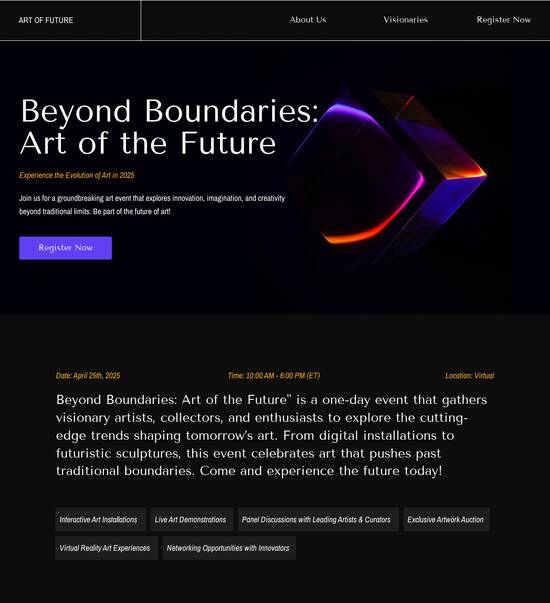
Bootstrap optimized e-learning platform template
Explore Similar TemplatesAbout template
Leverage our intuitive page builder and high-converting Bootstrap optimized e-learning platform template.
Recommended templates

Easy to build without coding
With the intuitive drag-and-drop builder, anyone on your team can create high-converting pages without any knowledge of code or design. Make enhancements to your landing page with custom widgets using Javascript, HTML/CSS, or third-party scripts.

Multiple layouts for any industry and goal
Select from 500+ landing page layouts built to boost conversions across industry-specific scenarios. Customize them by adjusting fonts, adding images, and generating on-brand content with the AI assistant. Quickly scale with Instablocks® and Global Blocks that you can save, reuse, and update globally.

Loads fast and looks polished on any device
Every template is responsive, which means they present professionally on any device and load blazingly fast with our Thor Render Engine. You can also power them up with Google AMP technology to deliver an unparalleled mobile experience and drive higher conversions.

Robust analytics & experimentation
Get real-time updates and reporting across all your devices, showing the number of visitors, conversions, cost-per-visitor, and cost-per-lead. Launch AI-powered experiments, run A/B tests, and use heatmaps to analyze user behavior, then optimize your landing page to maximize conversions.







Easy to build without coding
With the intuitive drag-and-drop builder, anyone on your team can create high-converting pages without any knowledge of code or design. Make enhancements to your landing page with custom widgets using Javascript, HTML/CSS, or third-party scripts.
Multiple layouts for any industry and goal
Select from 500+ landing page layouts built to boost conversions across industry-specific scenarios. Customize them by adjusting fonts, adding images, and generating on-brand content with the AI assistant. Quickly scale with Instablocks® and Global Blocks that you can save, reuse, and update globally.
Loads fast and looks polished on any device
Every template is responsive, which means they present professionally on any device and load blazingly fast with our Thor Render Engine.
Robust analytics & experimentation
Get real-time updates and reporting across all your devices, showing the number of visitors, conversions, cost-per-visitor, and cost-per-lead. Launch AI-powered experiments, run A/B tests, and use heatmaps to analyze user behavior, then optimize your landing page to maximize conversions.
All the features you need to build lead-generating landing pages
Explore more featuresLearn how to build top-performing landing pages for any goal
FAQs
Leading the way in building high-performing landing pages





A comprehensive guide to using Instapage for landing page optimization and conversion rate enhancement
Instapage offers powerful tools for marketers seeking to enhance their digital campaigns through optimized landing pages. With the focus on maximizing ROI and facilitating collaboration, it's essential to understand the key steps in leveraging Instapage for effective lead generation and conversion optimization.
Understanding landing page optimization
Landing page optimization is integral to creating a successful online marketing strategy. A well-optimized landing page can significantly increase conversion rates and enhance your ROI. Instapage provides robust features designed to facilitate this process, including ready-to-use templates and intuitive design tools.
- High-converting templates: Instapage offers over 100 customizable templates, enabling marketers to quickly launch campaigns without starting from scratch.
- A/B testing capabilities: Instapage allows users to conduct A/B tests effortlessly, giving insights into which variations lead to higher engagement and conversions.
- Analytics dashboard: With performance tracking tools, users can monitor landing page efficacy, identify areas for improvement, and make data-driven decisions.
Step 1: Building your first landing page
Creating a landing page on Instapage takes just a few clicks. Begin by selecting a template that aligns with your campaign goals, then customize it using the drag-and-drop builder.
- Choose a template: Select from a variety of conversion-focused layouts tailored to your audience.
- Personalize your content: Use dynamic text replacement to align messaging with your advertising for each audience segment.
- Integrate lead generation elements: Embed forms and call-to-action buttons that resonate with your visitors.
Step 2: Optimize for conversions
Once the page is built, focus on optimizing it for conversions to ensure you get the best results. This involves analyzing user behavior and making necessary adjustments.
- Utilize heatmaps: Analyze where users click or spend the most time on your page to identify content that engages or distracts.
- Conduct A/B testing: Experiment with different headlines, images, and CTAs to discover what combination yields the highest conversion rate.
- Refine based on analytics: Make data-driven adjustments based on the insights gained through performance tracking and testing.
Step 3: Collaborate and iterate
To maintain efficiency, utilize Instapage's collaboration features, allowing team members to provide instant feedback and make real-time edits.
- Invite team members: Share access with stakeholders for quicker reviews and approvals on designs and content.
- Implement instant feedback: Use commenting features to streamline the revision process.
- Test and iterate: Continuously refine landing pages by gathering insights from team collaboration and performance metrics.
Incorporating these steps into your workflow will enhance your landing page performance and drive effective results in your digital marketing campaigns.
Ready to maximize the power of your campaigns? Start with Instapage today and experience the difference it makes in achieving your marketing goals!
The evolution of e-learning: Bootstrap optimized templates as game changers
Understanding Bootstrap and its role in e-learning
Bootstrap is a highly popular open-source front-end framework originally created by Twitter. Its primary purpose is to facilitate the development of responsive and mobile-first websites, making it an essential tool for e-learning platforms. With Bootstrap, developers can create visually appealing and user-friendly interfaces that adapt seamlessly to various screen sizes. This adaptability is critical in reaching a broader audience in the educational sector, where learners may access content from desktops, tablets, or smartphones.
Responsive design: Ensures that e-learning platforms look good on all devices.
Customizable components: Offers a variety of UI elements that can be tailored to specific educational contexts.
Cross-browser compatibility: Guarantees that content is accessible to users on different browsers.
The significance of Bootstrap in educational technology cannot be overstated. By enhancing user experience and accessibility, it fosters engagement among learners, thus improving retention and overall satisfaction. Platforms built with Bootstrap can easily implement features like video lectures, quizzes, and forums, all of which enhance the learning experience.
Designing effective e-learning platforms with Bootstrap templates
To create a functional e-learning platform, it's essential to consider critical components within the Bootstrap template. A well-designed e-learning template should encompass various UI components that facilitate user interactions, including navigation bars, buttons, forms, and cards. These elements must be intuitive and consistent, making it easy for users to navigate.
Navigation bars: Allow users to easily move between different sections of the platform.
Buttons and forms: Essential for user interaction, such as signing up or submitting assignments.
Cards and modals: Enable instructors to showcase course descriptions and important announcements.
Additionally, Bootstrap templates should include base components tailored for educational contexts. This might involve course listings, detailed descriptions, instructor profiles, and student testimonials. Incorporating these elements not only enriches the learning environment but also builds trust by providing transparent information about the course offerings.
Another crucial aspect is the HTML structure of the templates. Utilizing semantic HTML can significantly improve search engine optimization (SEO), making it easier for potential learners to discover your platform. By following best practices in HTML coding, developers can ensure higher visibility of courses and better user engagement.
Admin dashboard: The control center for educators
The admin dashboard serves as the control center for educators, providing them with essential tools to manage e-learning platforms effectively. Core features of an optimized admin dashboard should include user management systems that allow educators to monitor students and instructors, course creation and management tools, and analytics for gaining insights into educational performance.
User management: Track student progress and instructor interventions.
Course creation tools: Streamline the process of uploading new content and creating modules.
Analytics: Generate reports that highlight performance metrics and engagement data.
Customization options for admin dashboards play a pivotal role in meeting the unique needs of educational institutions. Visual customization, such as themes and colors, allows for brand consistency, while functional choices like integrating third-party tools and APIs enable more specialized capabilities. For instance, connecting a dashboard to a learning management system (LMS) can enhance the overall management experience.
The course website design: A focus on user experience
Creating intuitive course layouts is vital for promoting engagement and ensuring efficient learning experiences. Structuring course content effectively—organizing it into modules, lessons, and quizzes—enables learners to grasp material at a suitable pace. Placing importance on multimedia elements like videos and infographics can also enrich course delivery, catering to different learning styles.
Modules: Break down content into manageable sections for easier understanding.
Lessons: Dive deep into topics, with clear objectives and outcomes.
Quizzes: Assess understanding and reinforce learning.
Moreover, implementing navigation best practices is paramount. Easy navigation enhances usability across the platform, allowing learners to find the information they need quickly. Features like breadcrumb trails, search functionalities, and clearly labeled categories contribute to a positive user experience, encouraging continued engagement with the course material.
Marketing websites for e-learning initiatives
Developing engaging landing pages is crucial for the success of any e-learning initiative. A high-converting landing page should incorporate essential elements that capture the attention of potential learners and convert them into actual participants. The design must focus on clarity, brevity, and persuasive visuals that lead prospective students through the enrollment process.
Compelling headlines: Quickly communicate the value of your offerings.
Clear calls to action: Direct users toward desired actions like signing up or requesting more information.
Social proof: Incorporate testimonials and success stories from previous users.
Incorporating SEO strategies into marketing pages is also essential for maximizing visibility. Performing thorough keyword research related to course offerings helps optimize content and improve search engine rankings. Strategies may include using long-tail keywords, writing informative blog posts, and leveraging user-generated content on social media to engage potential learners.
Reviewing the best Bootstrap optimized e-learning templates
An effective way to choose the right Bootstrap optimized template lies in reviewing and comparing different options available in the market. Many popular e-learning templates come with unique features that cater to the diverse needs of educators and learners. A feature versus benefits analysis can uncover which templates align best with your specific requirements.
Feature comparison: Examine what each template offers in terms of user interface and functionality.
Pricing: Review costs associated with each template and evaluate value for money.
Licensing: Investigate how licenses affect usage; for instance, single-site vs. multi-site licenses.
User reviews and community feedback can also provide valuable insights. Testimonials from educators who have successfully used these templates can highlight practical advantages and caveats. Forums and discussion platforms often feature discussions that share experiences, offering prospective buyers a broader context for decision-making.
Licensing and support considerations
When selecting a Bootstrap template for your e-learning platform, understanding licensing options is key. Most templates come with either single-site licenses, which are suitable for individual projects, or multi-site licenses, allowing for broader deployment across multiple units or departments. The choice of license can significantly impact the scalability and growth of your learning initiative, influencing whether you can expand your platform easily.
Single-site licenses: Cost-effective for standalone websites or one-off educational projects.
Multi-site licenses: Beneficial for institutions looking to create a cohesive learning experience across various programs.
The availability of technical support is another crucial factor. Many template providers offer customer support services through community forums, ensuring that users have access to documentation, troubleshooting help, and guidance on best practices. Having comprehensive onboarding materials can also facilitate the transition to a new template, enabling educators to leverage the design effectively.
Quality assurance in e-learning templates
Measuring quality and performance in Bootstrap optimized e-learning templates is essential for achieving successful outcomes. Metrics such as load time and responsiveness provide insights into a template's overall effectiveness. A template that is slow to load or difficult to navigate can detract from the learning experience, leading to increased dropout rates.
Load time: Evaluate how quickly the platform can deliver content to users.
Responsiveness: Check if the layout adapts smoothly across various devices and screen sizes.
Browser compatibility: Ensures a consistent experience regardless of the user's browser choice.
Regular updates and maintenance practices are also vital. Keeping templates up-to-date not only introduces new features but also strengthens security against potential vulnerabilities. Establishing strategies for proactive maintenance, such as regular content audits and user feedback collection, can significantly enhance the sustainability of an e-learning platform over time.
Innovations and future trends in e-learning templates
The landscape of e-learning templates is continuously evolving, influenced by emerging technologies and learner needs. One of the most significant trends is the rise of AI-powered customization, which tailors the learning experience based on individual user data. Such adaptive learning pathways can provide personalized recommendations, ensuring that learners receive content that aligns with their unique interests and goals.
AI-powered customization: Learning experiences tailored to individual learner data.
Interactive elements: Incorporating gamification and social learning to enhance engagement.
Personalization is becoming increasingly crucial. Utilizing machine learning to analyze learner behavior allows platforms to deliver a more customized content experience. This shift toward personalization can lead to higher satisfaction rates and improved learning outcomes as learners can engage with content that is directly relevant to their needs.
Crafting a cohesive e-learning experience
Integrating course delivery with communication tools is essential for fostering engagement within e-learning platforms. Utilizing tools like forums, chat systems, and webinars can create an interactive learning environment, enhancing the overall educational experience. Social media tools can also be integrated, enabling learners to share insights and connect with peers, thereby enriching the learning community.
Forums: Provide spaces for learners to discuss topics and share experiences.
Chat systems: Facilitate real-time communication between students and instructors.
Webinars: Offer opportunities for synchronous learning and interaction.
Feedback and iteration play a crucial role in shaping the e-learning experience. Continuous collection and analysis of learner feedback enables educators to identify areas for improvement and make necessary adjustments. Best practices for incorporating user insights into development include establishing regular feedback loops and actively implementing suggested changes, ensuring that the platform evolves alongside the needs of its users.
Ready to skyrocket conversions?
Supercharge your ad campaigns with high-performing landing pages
Get started














